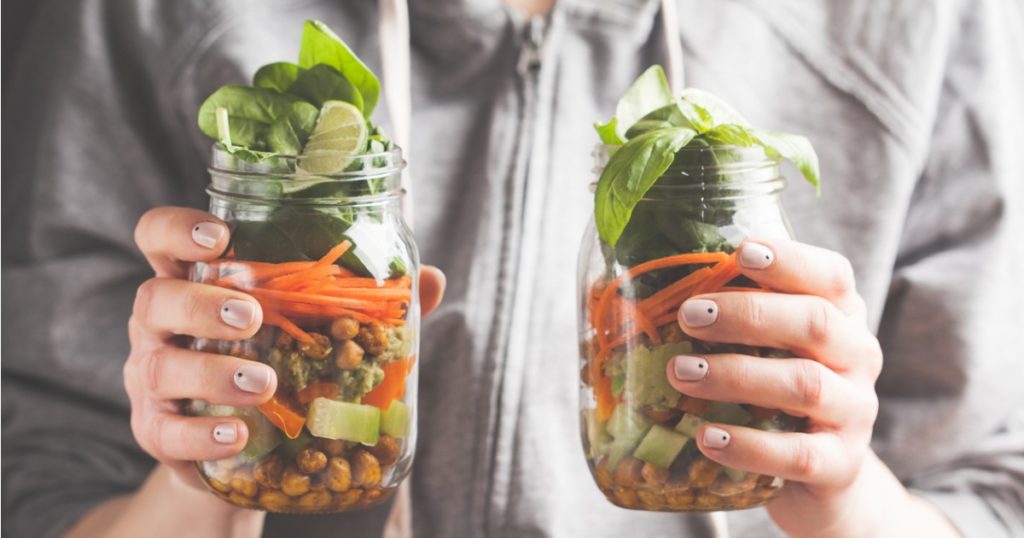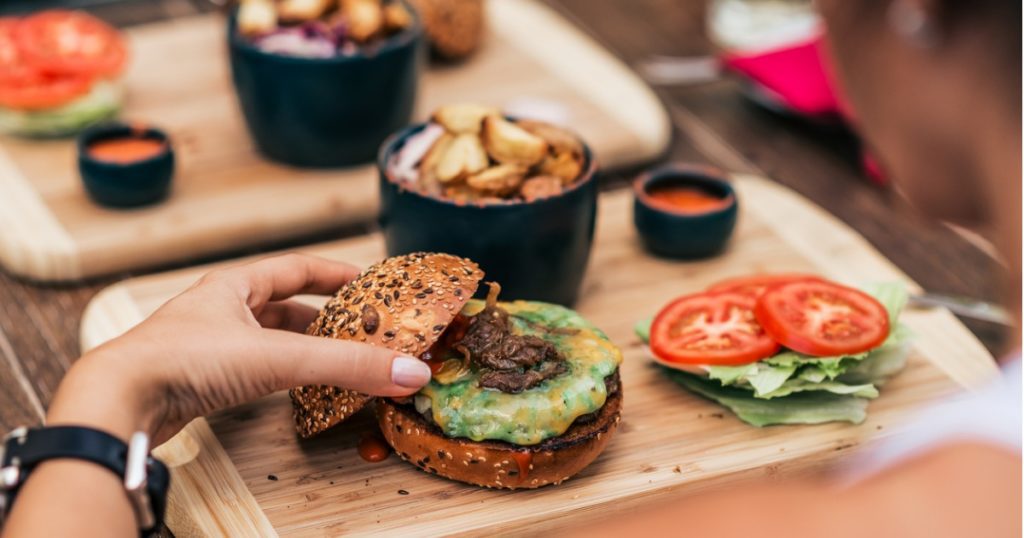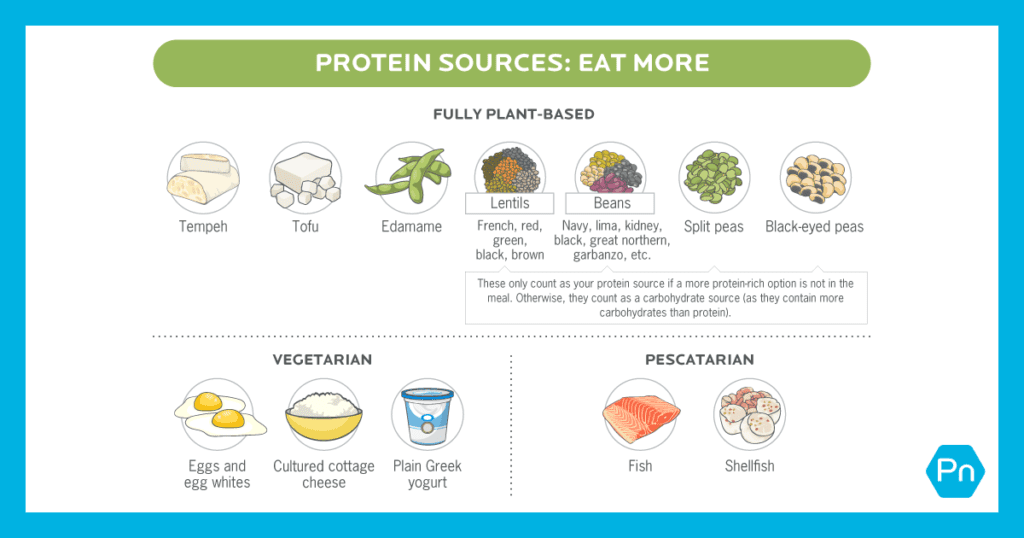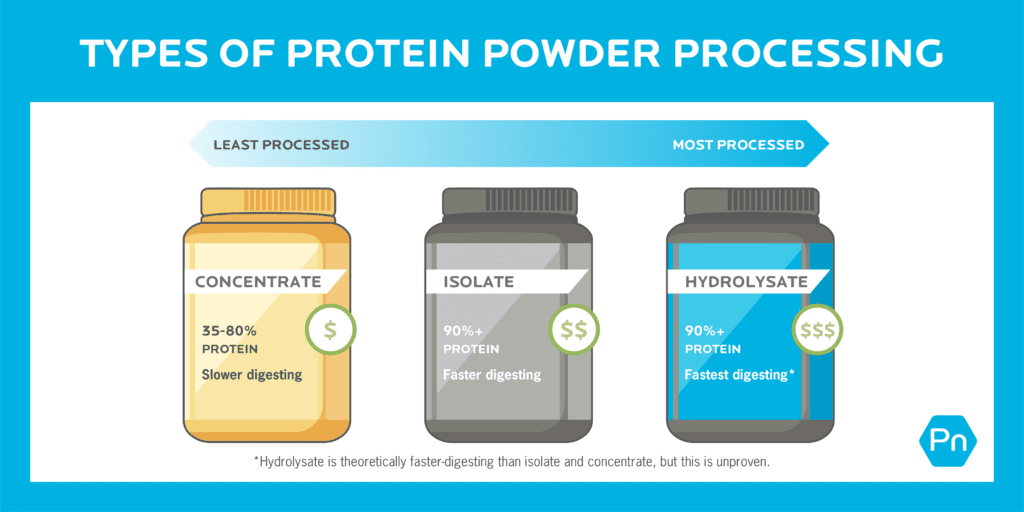Basics | Benefits | Risks | Coaching Advice | What to Eat | Diet Quiz
In my experience, there are at least two types of vegans:
Person #1: Their eyes twinkle, skin glows, and energy soars. They’re a walking, talking endorsement of 100 percent plant-based eating.
Person #2: Tired and pale, they look as if they’ve just lost two pints of blood.
In comment fields all over the internet, you’ll see Person #1 telling Person #2 that 100 percent plant-based diets are the absolute best way to eat—for everyone. And in the very same comment fields, you see Person #2 saying: “100 percent plant-based diets are dangerous!”
Who’s right? Who’s wrong?
Both—and neither.
I’m sure that answer sounds confusing. That’s because, as I’ll soon explain, the pros and cons of fully plant-based diets are nuanced. Some people benefit, while others struggle—and the reasons why are pretty surprising.
In this article I’ll dive into all of that, as well as:
- The many ways to be a vegan and fully-plant-based eater. (If you’re a coach, this information will help you better understand your vegan and fully plant-based clients).
- How the health benefits of a plant-based diet depend both on the types of plant foods someone consumes as well as on their genetics.
- Four nutrient deficiencies common in fully plant-based and vegan eaters—and how to overcome them.
- How to know if you’ll thrive (or struggle) on a fully plant-based diet.
- Advice for coaching 100 percent plant-based clients.
- What to eat on a 100 percent plant-based diet—and how to know whether the diet is working for you.
Let’s start with a question that isn’t remotely straightforward:
What are 100 percent plant-based diets?
Not everyone defines “fully plant-based” and “vegan” the same. Because of that, it’s helpful to start this story by explaining how Precision Nutrition uses these terms.
Plant-based nutrition
Though some people define “plant based” as “plants only,” our definition is broader and more inclusive.
For us, plant-based diets consist mostly of plants: vegetables, fruits, beans/legumes, whole grains, nuts, and seeds.
In other words, if you consume mostly plants with a small amount of animal-based protein, you’re a plant-based eater by our definition.
(Read more: A complete guide to plant-based nutrition.)
Whole-food plant-based diet
This eating pattern emphasizes whole, minimally-processed plant foods. Essentially, you’re eating plant-based foods as close as possible to the way nature grew them.
Fully plant-based diet
This eating pattern emphasizes foods from the plant/fungi kingdom, without any animal products.
Vegan diet
A vegan diet is a lifestyle. Vegans strive to avoid actions that bring harm or suffering to animals in any way.
In addition to not consuming animals, their eggs, or their byproducts (such as milk or honey), vegans often avoid purchasing products made from animals (such as fur or leather) as well as products that have been tested on animals or created with animal experimentation.
They also tend to boycott businesses that rely on animals for entertainment, such as circuses, rodeos, and bullfights.
Within the four main types of plant-based eaters listed above, there’s quite a bit of variation.
Take whole-food, plant-based eaters.
Few people eat only whole foods, so think of this eating style as a continuum.
On one end: Fully plant-based eaters who subsist mostly on store-bought cookies, crackers, white bread, and vegan hot dogs.
On the other end: people who consume lots of veggies, fruit, legumes, seeds, nuts, and grains.
We’d consider someone to be on a whole-food, plant-based diet if the majority of what they consume is both minimally-processed and plant-based.
Similarly, some fully plant-based eaters and vegans are more strict than others.
I’ve counseled some people who never consume animals or animal products. I’ve also worked with clients who are more flexible. They’ll make exceptions for certain foods in certain situations—such as when they’re at social gathering and vegan options are not available.
If you’re a coach, these nuances are important because they affect the health benefits and pitfalls your client might experience.
The benefits of fully plant-based diets
Many people assume that one of the big benefits of plant-only diets is this: They reduce risk for disease.
And a number of studies seem to support this.
For example, when researchers in Belgium used an online questionnaire to ask nearly 1500 vegans, vegetarians, semi-vegetarians, pescatarians, and omnivores about their food intake, they found that vegans scored highest on the Healthy Eating Index, which is a measure of dietary quality.1
Because of this improved dietary quality, fully plant-based eaters and vegans tend to have a lower risk for a wide range of diseases.2,3,4,5,6
But there’s an important caveat: Vegans and fully plant-based eaters score higher on the Healthy Eating Index not because they forgo meat, but rather because they tend to eat more minimally-processed whole plant foods such as vegetables, fruits, beans, nuts, and seeds.
In other words, many fully plant-based eaters tend to follow a whole-food, plant-based approach.
And according to a huge, long-term study, the inclusion of minimally-processed whole foods may be key to reaping the benefits of a vegan diet.
When researchers looked at health outcomes of hundreds of thousands of female nurses as well as dozens of male health professionals over more than two decades, they found that heart disease risk depended on the types of plant foods people consumed.
Vegetarians and vegans who consumed mostly minimally-processed whole foods had a lower risk of developing heart disease. Vegetarians and vegans who consumed an abundance of fries, sweets, sugary beverages, and other highly-processed foods, however, had an increased risk.7
The cons of fully plant-based diets
Any time someone omits entire food groups, that person must work harder to get all the nutrients their body needs. People who are fully plant-based or vegan tend to struggle with four nutrients in particular.
Calcium
In addition to keeping bones and teeth strong, calcium helps muscles—including your heart muscle—work properly.
Because vegans omit dairy products—which supply nearly a third of the 1000 to 1200 milligrams of calcium the typical person needs everyday—they’re at risk for calcium deficiency.
Case in point: A recent review of 20 studies involving 37,134 people found that vegans had lower bone mineral density and higher fracture risks than meat eaters—or even vegetarians.8
To get enough calcium from non-dairy foods, use this advice.
▶ Consume several servings of high-calcium plant foods a day.
Calcium-rich plant foods include leafy greens (collards, turnip greens, kale), calcium-set tofu, calcium fortified plant milks, sesame seed butter, black strap molasses, okra, broccoli, figs, beans, almonds, edamame, and soy nuts.
To increase absorption, cook calcium-rich greens before eating.
▶ Cut back on salt, alcohol, and soft drinks.
When people consume a lot of alcohol, salt, and soft drinks, they tend to take in fewer nutrient dense, minimally-processed whole foods.
For example, when someone chooses a soft drink, they’re not choosing a calcium-enriched plant milk. When they sit down with a bowl of salty chips, by default they’re not having broccoli, figs, or soy nuts.
Many soft drinks are also a rich source of phosphoric acid, which may throw off the body’s calcium-phosphorus balance.9,10,11,12,13
▶ Exercise.
Resistance training (like weight lifting) and weight-bearing cardio (think jogging and tennis) both stimulate bones, helping to protect against bone loss.14
Vitamin B12
This vitamin helps bodies to form DNA, strengthen and repair blood vessels, and protect nerves.
Because B12 is involved in red blood cell formation, deficiency can lead to a decrease in red blood cells (a condition called pernicious anemia).
Though a few plants contain substances that the body can convert to B12, we don’t absorb and use these substances as readily as the form of B12 present in animal products.15
Plus, many people over age 50 are already deficient, whether they eat meat or not. That’s because, as we age, our stomachs make less acid (which helps metabolize B12) and intrinsic factor (which helps the body absorb B12). And some medications—such as acid blockers—reduce absorption even more.
For these reasons, a daily B12 supplement is the best approach for:
- People over 50.
- People who take medications that interfere with vitamin B12 absorption, such as those used to treat reflux, ulcers, and diabetes.
- People who are partially or fully plant-based.
Even with supplements, some people might show signs of deficiency: fatigue, dizziness or loss of balance, and reduced mental function.
In those cases, their health care provider can check their B12 levels with a blood test and potentially prescribe intramuscular (injected) B12, which is better absorbed than oral (including sublingual) supplements.
Omega-3 fats
These fats help prevent heart disease. They’re also involved in the development of eye, nerve and brain tissue (especially in fetuses and babies).
Omega-3 fats come in a few forms:
▶ Eicosapentaenoic acid (EPA) and docosahexaenoic (DHA)
The richest sources of EPA and/or DHA generally come from the oceans. Fatty varieties of seafood are particularly rich sources: salmon, tuna, herring, mackerel, sardines, and oysters. Vegans can get smaller amounts from sea vegetables (think: seaweed and algae).
▶ Alpha-linolenic acid (ALA)
Plant foods rich in ALA include flax seeds, chia seeds, hemp seeds/hearts, walnuts, soy, dark leafy greens, and cruciferous vegetables.
Our bodies must convert ALA into EPA or DHA before using it. About 90 percent of the ALA fat is lost during the conversion. In other words, if you consume 2.5 grams of ALA from plants, your body will only convert and use about 10 percent, or about .25 grams.16
Bottom line: To optimize their omega-3 intake, fully plant-based eaters should try to consume legumes, nuts, flaxseed oil, ground flaxseed, walnuts, and other ALA-rich foods daily.17
If needed, consider adding a vegan (algae-based) DHA supplement.
Iron
Because iron carries oxygen around the body, low levels can lead to fatigue.
Animal products are a particularly rich source of a type of iron called heme that our bodies easily absorb. Plants like beans, peas, and lentils contain non-heme iron that isn’t as readily absorbed. To help boost iron intake and absorption, use this advice:
▶ Cook with cast iron cookware. It can increase the iron content of the food you eat.18
▶ Don’t drink coffee or black tea with food. These drinks contain tannins that inhibit the absorption of iron.
▶ Consume vitamin C powerhouses. They can boost absorption when consumed with iron-rich foods. Use the chart below for ideas. For example, make a tofu stir fry with broccoli or a bean salad with tomatoes, peppers, and a squeeze of lime.
| Rich in non-heme iron | Rich in vitamin C |
|---|---|
| Pumpkin seeds
Tofu Tempeh Edamame (soybeans) Lentils Beans Peas Sunflower seeds Nuts Hummus Almond butter Leafy greens Fortified foods Potatoes White and oyster mushrooms Amaranth Spelt Oats Quinoa Dark chocolate |
Citrus fruit and juices (ex: oranges)
Cantaloupe Strawberries Broccoli Tomatoes Peppers Winter squash Watermelon Guava Kale Kiwi Potatoes |
People who thrive on vegan and fully plant-based diets
As I mentioned at the beginning of this article, some people flourish on vegan and fully plant-based diets, whereas others tell me they can’t perform in the gym, are hungry 24-7, and just feel terrible.
Here’s what makes the difference.
People who do best:
✓ Have a genetic predisposition that suits them for this eating style. They feel fantastic when they eat more plants and less (or no) meat.
✓ Like eating minimally-processed whole plant foods such as vegetables, beans, and lentils.
✓ Are willing to put in the effort to include foods rich in key nutrients or/and take supplements as needed to avoid deficiencies.
✓ Have an open-minded “I’ll try anything once” approach to eating. No vegan option is off-limits. (Algae smoothie, anyone?)
✓ Have the time and inclination to search out vegan restaurants, meal-delivery options, and recipes.
✓ Have support from family/friends.
✓ Have a deep “why” for being 100% plant-based, such as, “Protecting and preserving the wellbeing of animals is a priority for me.”
✓ Are flexible about their plant-based identity. They’re okay consuming eggs, dairy, seafood, or even meat from time to time, if no other options exist.
People who struggle:
✓ Feel physically terrible when they stop eating animal protein, even if they’re taking steps to patch deficiencies.
✓ Cook for picky eaters who either love meat or hate plant foods—or both.
✓ Prefer highly-processed refined foods over whole plant foods.
✓ Lack a strong “why” for going plant-based.
✓ Lack the time and energy to investigate new recipes or restaurants.
How to coach someone on a fully plant-based diet
To help clients avoid deficiency and stay consistent, use this advice.
Don’t assume a vegan or fully plant-based eater never eats meat.
It’s counterintuitive yet true: Some people who identify as vegans or fully plant-based eaters will consume animal products in certain situations.
As a coach, this is important information—because flexibility can help your clients avoid deficiencies.
Ask questions like:
- What does “vegan” or “strictly plant-based” mean to you?
- Could you tell more a little more about what foods you enjoy eating and what foods you choose to eliminate?
- What do you eat and how often?
- What did you eat yesterday?
The answers may surprise you.
When I posed those questions to a college-aged client, she said, “I am a strict vegan, except when I’m drunk. Then I get fast food and will order a hamburger.”
When asked how often she drank, the client answered, “Well, I party three times a week, so I get hamburgers three times a week. But otherwise I am a strict vegan.”
Help clients ease in.
Some of your clients will attempt to go from a meat-heavy to a strict vegan diet overnight. Often after they’ve watched a documentary about the benefits of plant-based diets.
While this commitment to big, fast dietary change is commendable, it often ends in frustration. Why? Strict vegan and fully plant-based diets require clients to know and use several skills. Consider:
- How does one make tofu taste like bacon? Or chicken? Or paneer?
- What brands of vegan yogurt taste the best? What about plant-milk?
- Which vegan-sounding packaged foods actually contain animal-based ingredients such as rennet, chicken broth, or gelatin? (Hint: Your clients will want to carefully read the labels on commercially-prepared breakfast cereals, soups, condiments, stuffing mixes, yogurt, and candy, among other foods.)
- What should they say when friends invite them over for dinner and all of the options include meat or animal products?
In other words, switching from omnivore to vegan will mean learning how to cook a wide range of foods and recipes, shopping for different foods, and navigating social situations in completely new ways.
Because of that, I’ve found that clients ultimately are more successful if they ease in.
To do this, imagine a fully plant-based or vegan diet as a volume dial. A 10 on the diet is 100 percent plants, 100 percent of the time. A zero is their current way of eating.
They might turn their dial up to a 1—cooking one vegan meal a month or week. Then, if that goes well, they might advance to what they define as 2 or 3. And so on. They might not ever get all the way to 10—and that’s okay. As long as they’re adding more plant foods to their diet, they’re making progress.
Should you talk clients out of a vegan diet?
In a word, no.
When you dictate the terms, your client no longer feels like you’re in it together. Rather than your carefully thought-out reasons, your client hears: “My coach thinks I’m wrong.”
And that doesn’t feel good.
So what do you do if your client wants all-in on a vegan diet—but you suspect they may not be ready? You might say:
“Wow, that’s so great that you’re really taking initiative and learning more about nutrition on your own time! That’s awesome.
We can go at this a couple of ways. We can explore a strict plant-based plan right off the bat.
Or we can continue on with the old plan for a while.
Another option: We blend the two plans and see if we can find the best of both. In other words, you would keep what you like about your current plan, and adopt a few things from plant-based eating.
Maybe, for example, you try a meatless meal once or twice a week. Or if you really want to ramp up your plant-based eating, aim for meat-free before dinner, most days of the week.
Of those options, what feels like a good fit to you?”
Once they’ve chosen a direction, respect that decision, and use your coaching wizardry to help them overcome obstacles.
Ask clients about their favorite foods.
There are plenty of super high-tech ways to test people for nutrient deficiencies, such as running their food diary through a nutrient database.
But if you don’t have access to decent nutrition software, there’s a low tech option: Show clients lists of foods that are rich in calcium, B12, iron, and healthy fats. Then ask them to do two things.
- Cross out foods they don’t eat
- Circle foods they do eat
For example, let’s say you’re looking at a list of calcium-rich foods. The client might cross out cheese, ice cream, yogurt, and all other dairy products. Then, of the foods that are left, the client circles leafy greens, calcium-set tofu, broccoli, figs, beans, edamame, and almonds.
“I really don’t like sesame seed butter,” the client says, “And I’ve never heard of blackstrap molasses.”
That gives you something to work with. Once you know what foods the client likes to eat, you can work together to come up with recipes and meal prep strategies to help your client eat those foods more regularly.
Know that, for some people, fully plant-based and vegan diets just don’t work.
As I’ve mentioned: Some people do amazing on fully plant-based and vegan diets. Their skin glows. They have a pep in their step. They seem energized, healthy, and vibrant.
Other people, however, seem as if they’re wasting away.
They’re hungry all the time. They can’t stop thinking about cookies, brownies, and bread. And they may even have signs of deficiencies: fatigue, insomnia, thinning hair, brittle fingernails, and broken blood vessels.
The most telling piece of evidence: When they tell me, “If I eat a little bit of meat, I feel better.”
It’s tempting to assume this is evidence the client is doing vegan “wrong.” But for at least some people, there may be a deeper, genetic component.
I’ve counseled couples who are doing vegan diets together. One person is vibrant whereas the other is struggling. Same diet (heck, even the same table). Just different bodies.
I call this “failure to thrive on a plant-based diet.”
If this describes a client who otherwise seems to be eating an abundance of minimally-processed whole foods, it’s time to ask the question: Is this diet really working for you? (The self assessment below will help you find out).
The fully plant-based diet: What to eat
This is probably a bit of a no-brainer, but I’ll say it anyway: People on 100 percent plant-based diets tend to eat a lot of plants: veggies, fruit, legumes, nuts and seeds, whole grains, and vegetable oils.
Depending on the person, they might occasionally include animals or animal products—a little fish sauce here, a whipped cream topping there.
Ultimately, the goal for all plant-based clients isn’t perfection.
Rather, it’s progress: Eat more minimally-processed whole plant foods and fewer highly-processed refined foods and animal products. No matter what kind of a plant-based eater they are, this infographic will help them approach that goal.
For a more complete, customized plan, plug your info into our Nutrition Calculator. (It’s FREE and is personalized for your eating preferences, goals, and lifestyle.)
Fully plant-based diets: Do they work—for you?
For best results, think of a new plant-based or vegan diet as a mini research study with a sample size of one—you (or your client).
▶ Define what fully plant-based means to you or your client.
▶ Try it for a few weeks and then evaluate how it all went. Did it work? Do you look, feel, and perform better?
For help, use this short quiz—it’ll help you assess if your vegan diet is working for you. You can come back to the quiz time and again—and for any diet approach—so you might want to bookmark it.
▶ Based on what you learn from your experiment, either stay the course, make some changes to improve your success (say, more beans, fewer chips), or abandon the mission.
No matter your results, remember this: it’s okay.
This isn’t about earning awards for plant-based perfection. It’s about progress, consistency, and finding out what works for your body
And if you ultimately decide that fully plant-based eating just isn’t for you, it’s no big deal. There are so many other ways to eat—Mediterranean, keto, intermittent fasting, or paleo, to name a few. Or consider trying the “anything” diet laid out in our Precision Nutrition Macro Calculator. Keep experimenting with new things.
Eventually, you’ll land on the best diet—for you.
References
Click here to view the information sources referenced in this article.
If you’re a coach, or you want to be…
You can help people build sustainable nutrition and lifestyle habits that will significantly improve their physical and mental health—while you make a great living doing what you love. We'll show you how.
If you’d like to learn more, consider the PN Level 1 Nutrition Coaching Certification. (You can enroll now at a big discount.)







Share